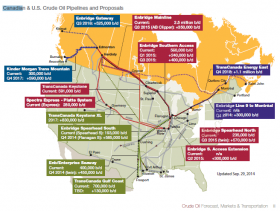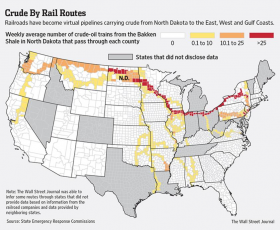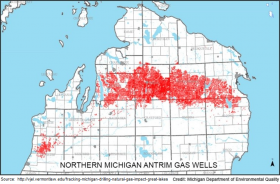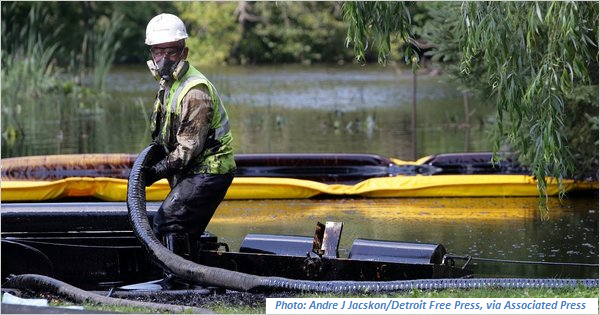This post was authored by Ryan Strode, a director in Arabella Advisors’ Chicago office.
Since 2010, major public and philanthropic investment has focused on improving the health of the Great Lakes, on which millions of Americans and billions of dollars of economic activity depend. Now, rapidly escalating fossil fuel development is posing new threats to the Great Lakes region. Left unchecked, a surge in oil and gas development in the bi-national Great Lakes could reverse recent gains made in the basin, as well as threaten public safety and air and water quality.
This issue has attracted the attention of diverse funders, including those who focus on the Great Lakes, clean energy, environmental health, and/or social justice. Though these funders have different priorities and serve different populations, they all have reason to be concerned about the impacts of fossil fuel extraction in the basin.
These issues were recently explored in an informational webinar jointly hosted in March 2015 by the Great Lakes Funder Collaboration (GLF) and the Health & Environmental Funders Network (HEFN). Presentations outlined the growth of the fossil fuel industry in the region, its potential impacts on human and ecological health, and advocate perspectives. In discussion funders began exploring opportunities to effectively respond to the mounting threat posed by increasing fossil fuel development in the Great Lakes basin, including through collaboration across sector and geographic boundaries.
What’s Happening – and What’s at Stake
About 35 million Americans rely on the Great Lakes for their drinking water. The Lakes also support a shipping and fishing industry worth $8 billion annually. Over the past decade, Great Lakes advocates have made significant gains in restoration, water quality, and conservation. This largely has been driven by the historic Great Lakes Restoration Initiative, which has invested $1.6 billion in more than 2,000 projects since 2010, in addition to investments by Canadian and US foundations and other stakeholders.

Yet the region is experiencing a marked expansion in the extraction, transportation, and refining of fossil fuels, which introduce a wave of potentially very harmful consequences.
As oil production in North America surges, more oil is being transported through the Great Lakes basin which is strategically located between US and Canadian extraction sites, refineries, and shipping ports on the coasts. Oil is transported over local waterways via pipelines (9,122 miles of pipe in the Great Lakes region alone), rail, and tanker trucks—each with distinct risks, as highlighted by a recent Cornell University report. The aging pipeline infrastructure —with 55 percent of lines installed prior to 1970—is increasingly prone to spills. Between 2000 and 2009, there were 559 oil spills in the Great Lakes states. In 2010, nearly one million gallons of diluted bitumen (or “tar sands”) spilled into the Kalamazoo River.
Rail infrastructure is aging as well, leading to an increase in catastrophic accidents. In 2013, a train hauling oil exploded, destroying a Quebec town and killing 47 people. These catastrophes will only increase as oil production increases. Tellingly, the total number of gallons of oil spilled from rail cars in 2013 exceeded the number of gallons from all spills between 1975 and 2012 combined.

The threat of oil spills and explosions gravely imperils human health, drinking water supplies, and valuable ecosystems. Oil—particularly tar sands—carries toxins that can become airborne, degrade topsoil, and contaminate aquifers for decades.
The shale gas industry is also drawing closer to the Lakes. The region is rich in silica sand, used in hydraulic fracturing—or “fracking;” there are 34 sand mines in the Great Lakes basin. Sand mining releases silica sand into the air, which poses a serious human health risk; it contaminates nearby water supplies with chemicals used in the mining process, and demands a significant amount of water from the watershed. There are currently few regulations for dealing with these hazards.
There also is the potential for increased natural gas exploration and extraction within the Great Lakes watershed. For example, Michigan harbors some of the US’ most abundant natural gas reserves —including the Antrim and Collingwood Shales, both of which cross into the Traverse Bay Watershed.

Drilling of natural gas wells in the Great Lakes basin could have tremendous implications for habitat and water quality and quantity. In 2010, the Collingwood/Utica Shale wells drew 5.5 million gallons of water. Similarly, these wells produce untreated wastewater that contains toxic chemicals; the state of Michigan allows these chemicals to be disposed of by spraying them onto roads for dust control, which then runs off into local waterways.
Opportunities to Protect the Great Lakes
In the face of this mounting threat, the collective strengths of existing networks within the Great Lakes and health and environmental communities are needed to respond. Fortunately there already exist a number of avenues for collaboration. Funders can leverage budding partnerships between Great Lakes advocacy organizations in the US and Canada, including a bi-national conference of the Great Lakes Funders Collaborative in Toronto on October 8-9, 2015. HEFN is hosting a funder briefing in November on strategies to curb the impacts of oil and gas infrastructure nationally.
Funders can build on early efforts to raise awareness within Great Lakes communities and organize a grassroots response. For example, the “Oil and Water Don’t Mix” campaign has helped to raise the visibility of tar sands pipelines in the Great Lakes and to identify tangible steps regulators can take to mitigate risks from Enbridge’s Line 5 pipeline, which runs under the Mackinac Straits.
Tar sands advocates — including 350.org, Sierra Club, National Wildlife Federation, and Interfaith Power and Light— are working to further build momentum by organizing a June “Tar Sands Resistance March” in St. Paul, MN. Thus far, these campaigns remain largely focused at the local and state level; advocates would need additional resources to coordinate and grow campaigns across the basin.
Together, we can help to build bridges across diverse stakeholders to develop a coordinated, comprehensive response to the fossil fuel industry’s expansion in the Great Lakes.
The recent GLF/HEFN webinar highlighted needs where funders could have an immediate impact, including:
- Convening an interdisciplinary working group of leading advocates to consider lessons from existing industry campaigns, assess knowledge gaps in the region, and design a coordinated strategy for the Great Lakes;
- Strengthening the capacity of existing Great Lakes organizations and networks to monitor, raise awareness of, and organize grassroots campaigns to address threats posed by fossil fuels;
- Addressing critical knowledge gaps associated with oil transportation by rail, including emergency management, monitoring of the amount of crude being shipped, and infrastructure needs; and
- Assessing the potential for shale gas expansion into the Great Lakes basin, including the role of relevant policies such as the Great Lakes Compact, which governs the use of Great Lakes water supplies.
The myriad challenges posed by the expansion of the fossil fuel industry in the Great Lakes transcend any one sector, population, or community. They are too great for a single funder or type of funder to address alone, but a diverse coalition of funders could bring their collective resources and knowledge to bear to have significant impact on this pressing issue.
The Great Lakes Funders Collaborative and Health and Environmental Funders Network would like to thank the speakers on our webinar, including:
- Ted Auch, FracTracker Alliance
- Susan Christopherson, Cornell University
- Adam Scott, Environmental Defence
- Moderator: John Mitterholzer, of the George Gund Foundation.

Ryan Strode is a director in Arabella Advisors’ Chicago office, where he provides strategy, evaluation, and project implementation guidance to clients and contributes to the firm’s business development efforts. His work with clients has included development of philanthropic strategies around climate change mitigation and adaptation, clean energy, and ecological conservation and restoration, as well as management of a fund dedicated to restoring and protecting Lake Michigan.

